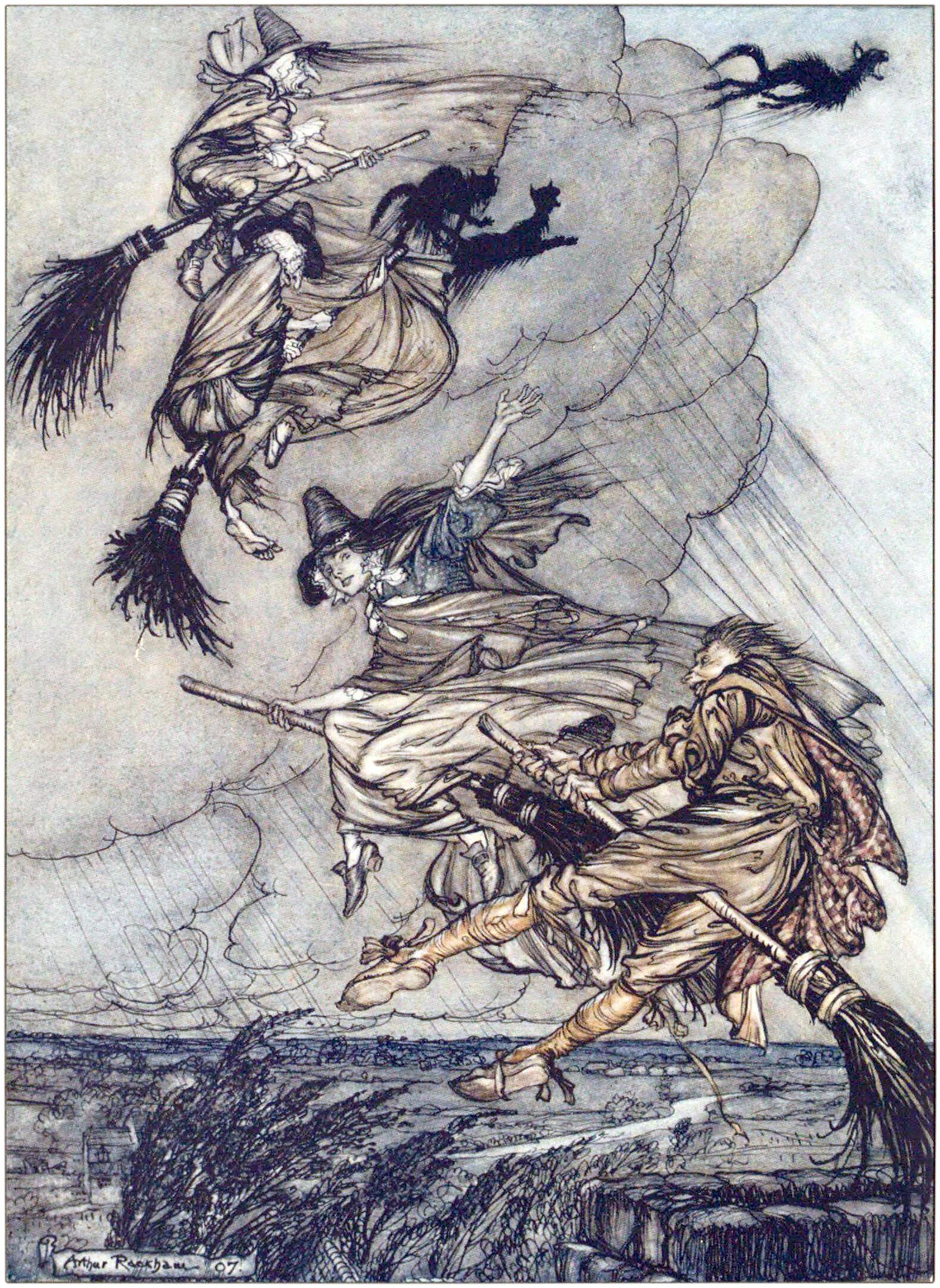The Witches’ Frolic
Illustration by Arthur Rackham showing a group of witches flying on their broomsticks. Taken from the Thomas Ingoldsby legend The Witches’ Frolic.
Pictured above is an illustration by Arthur Rackham showing a scene from the Thomas Ingoldsby legend The Witches’ Frolic. The story follows the young man Robin as he interacts with a group of witches, and verticality is featured throughout the tale.
The story begins with Robin, waiting for his lover in the pouring rain. He waits near the ruins of an old abbey, but his lover has decided not to come because of the weather. Cold and inpatient, Robin notices a flickering light in the abbey, and goes to investigate. He finds a group of three witches, each with a broomstick and a black cat. Two of the witches are old, while the third is young and quite pretty. He is frightened by them, but he also falls for the young witch instantly. She calls to him, and convinces him to come dance with her. They dance, and then they all decide to have a feast and drink together. The group flies off on their broomsticks, with Robin in tow, to find food and drink. They proceed to break into a few people’s houses and the witches cast a spell on everyone in the houses to put them asleep. They then raid the pantry. As they eat and drink, the witches make toasts to the devil. During one toast Robin decides to get in on the action, and makes a toast that mentions Noah from the bible. This causes the witches to choke on their wine, breaking the spell. Everyone in the house wakes up and catches the group eating and drinking in the pantry. The witches quickly fly away, leaving Robin to take the blame for their crimes and to get beat up by everyone in the house.
The next morning, Robin is taken to the local squire to receive punishment for his crimes. As his crimes are read aloud, a witch runs in and grabs Robin, then flies out of the room with him. The story ends with Robin waking up near the ruins where the story began, with a massive hangover. The moral of the story? Young men shouldn’t drink too much and shouldn’t be tempted by pretty girls.
A painting by Albert Joseph Penot from 1910 called Départ pour le Sabbat, which means Departure for the Witches' Sabbath.
Witches are common figures in medieval folklore. Traditionally, they had supernatural powers gained from confiding in evil spirits. Among these powers was the ability to fly. In some stories they had wings. In other stories they could simply levitate around. Most of the time, however, they used magic broomsticks to fly. This ability to fly gave them considerable advantages over those who couldn’t. Throughout The Witches’ Frolic, the witches are able to come and go as they please because they can fly. Robin can’t fly, so he’s stuck to face his punishment until the witch flies in and takes him away. It’s a classic little tale that shows the power of verticality for those who achieve it.
Witches have been portrayed by artists countless times throughout history, and the most common way to show them is in flight. Their ability to fly is a defining characteristic for these magical women, while the rest of their supernatural powers are ancillary. Pictured above is one such example, with a young witch sitting on her broomstick, flying through the air.
Flight is a common trope in folklore, and many examples of creatures who can fly are scattered around. These include angels, seraphs, cherubs, fairies, magic carpets, and flying horses, to name a few. All these examples come together to show that humans have been obsessed with verticality long before we were able to achieve flight.
Check out other posts about folk tales that deal with verticality here.


